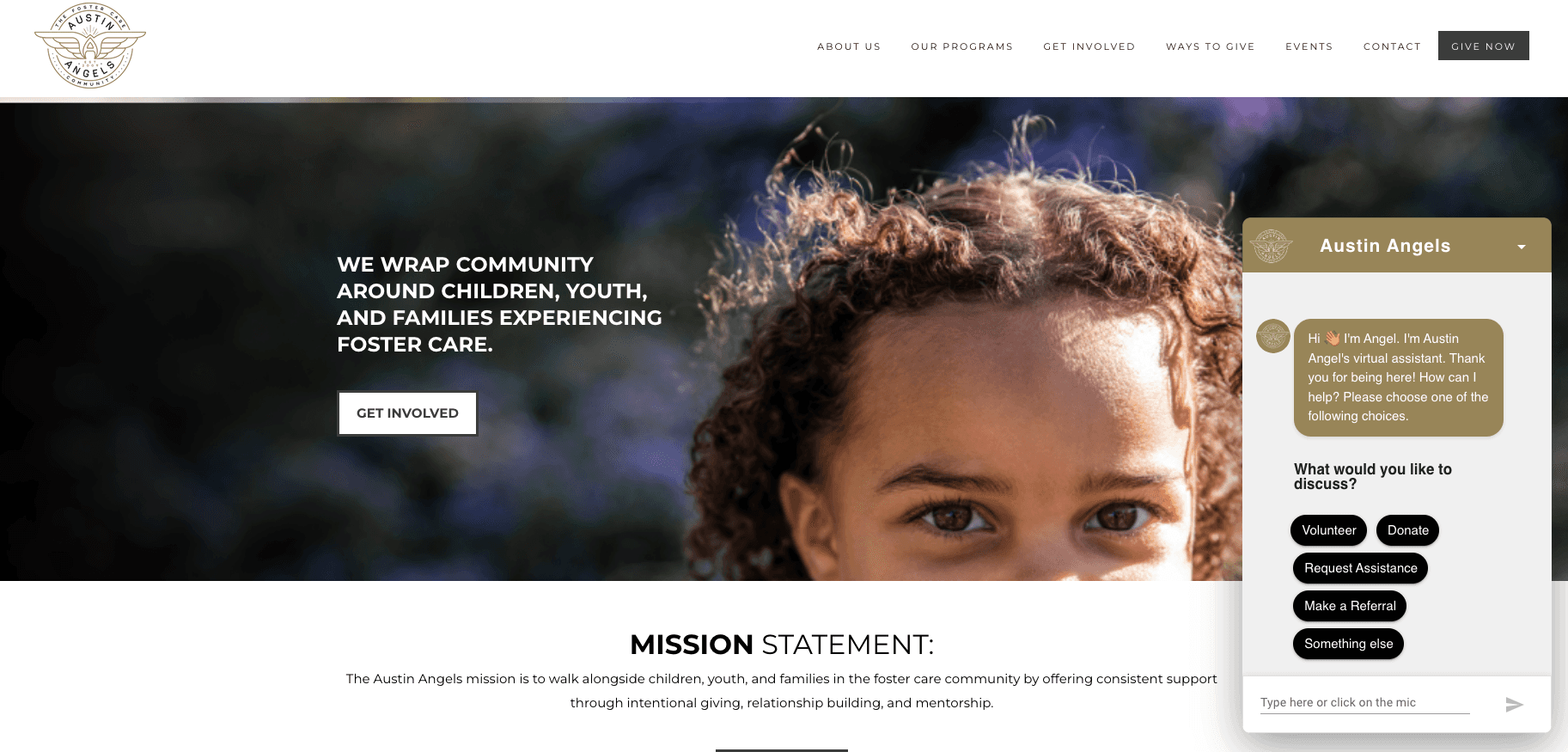Published
Sep 20, 2024
People power drives nonprofit missions. In this post, we look at some of the challenges nonprofits face recruiting volunteers and explore how AI can turn those challenges into success stories of speed, efficiency, and connection.
Volunteer Recruiting

Chris Miller
CEO & Founder
People power drives nonprofit missions. In this post, we look at some of the challenges nonprofits face recruiting volunteers and explore how AI can turn those challenges into success stories of speed, efficiency, and connection.
Picture this: It's 11 PM on a Tuesday. Jim, a busy professional with a heart of gold, is browsing your nonprofit's website. He's inspired by your mission and excited about the possibility of volunteering. But he has questions. Important ones. About time commitments, specific roles, and how his skills might fit in.
In the past, Jim would have had two options: fill out a contact form and wait (hoping his enthusiasm doesn't wane in the meantime), or make a mental note to call during business hours (a note likely to be buried under the avalanche of tomorrow's to-do list).
We all know how this story often ends. Life happens. Work deadlines pile up, family commitments take priority, and that spark of enthusiasm Jim felt fades into the background of his busy life. Days turn into weeks, and your nonprofit has lost a potentially valuable volunteer - all because of a simple timing mismatch.
This scenario plays out countless times across the nonprofit sector. It's a problem that's been around for years, hiding in plain sight. We've gotten so used to it that we almost don't see it anymore. Almost.
But here's the thing: in a world where you can order a pizza with an emoji or get personalized movie recommendations at 3 AM, should connecting with a nonprofit really be stuck in 2004?
Enter AI-powered volunteer recruitment.
At MyRecruiter, we've witnessed firsthand how conversational AI is reshaping the landscape of nonprofit volunteer recruiting. Our mobile-first virtual recruiting assistant is breaking down barriers, making it easier than ever for nonprofits to connect with interested individuals at the moment inspiration strikes - whether that's at 11 PM on a Tuesday or 6 AM on a Sunday.
In this post, we're going to dive into how AI is revolutionizing volunteer recruitment for nonprofits. We'll explore:
The unique challenges nonprofits face in volunteer recruitment and how AI is flipping the script
Real-world success stories that'll make you rethink what's possible in volunteer engagement
The unexpected benefits of AI-powered recruitment that go way beyond just filling volunteer slots
Practical steps your nonprofit can take to join the AI revolution (no computer science degree required!)
So, whether you're a small local charity or a large international organization, buckle up. We're about to embark on a journey into the future of nonprofit engagement – a future that's smarter, more responsive, and ironically, more human than ever before.
Ready to discover how your nonprofit can turn missed connections into meaningful engagements in the age of AI-powered recruitment? Let's dive in!

Volunteer Recruitment Challenges: How AI is Flipping the Script
Before we dive into the Austin Angels success story, let's take a moment to acknowledge the elephants in the room – the unique challenges nonprofits face regarding volunteer recruitment.
The Recruitment Struggle is Real
According to "The State of Volunteer Engagement" report by the University of Maryland's Do Good Institute, Nearly half (46.8%) of nonprofit CEOs say that recruiting sufficient volunteers is a "big problem" for their organizations. That's nearly half of all nonprofits struggling with the very lifeblood of their operations!
The Time Crunch Conundrum
First up, there's the ever-present time crunch. Nonprofits often run lean, with staff wearing multiple hats and juggling a million tasks. The Do Good Institute reports that 28.7% of nonprofits operate with less funding and paid staff than before the pandemic.
Finding time to respond promptly to every volunteer inquiry is like trying to catch raindrops in a thunderstorm—a noble effort but nearly impossible.
The 24/7 Expectations in a 9-to-5 World
Then there's the mismatch between potential volunteers' availability and your staff's office hours. Many volunteers prefer to communicate with organizations outside of traditional business hours. That spark of "I want to help!" doesn't always conveniently happen between 9 and 5, Monday through Friday, but that's when most nonprofits are staffed to respond.
The Information Overload and Website Woes
Let's not forget the challenge of providing consistent, accurate information to every inquiry. With programs changing, needs evolving, and opportunities shifting, keeping everyone on the same page can feel like herding cats. Moreover, your website – often the first point of contact for potential volunteers – might be working against you. Network Depot reports a 60-70% bounce rate for nonprofits. That's a lot of missed connections!
The Follow-Up Fizzle
And how about the follow-up? We all know that initial enthusiasm can fizzle if not nurtured. But keeping track of every interaction, remembering to follow up at the right time, and personalizing each communication? It's enough to make even the most organized among us break out in a cold sweat. The National Council of Nonprofits reports that inconsistent communication is one of the top reasons volunteers disengage from organizations.
Enter AI: The Game Changer
Now, here's where AI enters the scene, not with a whimper, but with a bang. It's flipping the script on these challenges in ways that are nothing short of revolutionary:
Always-On Availability: AI doesn't clock out at 5 PM. It's there to engage with potential volunteers 24/7, 365 days a year. That midnight burst of "I want to help" gets an immediate response, not a "we'll get back to you on Monday."
Consistent, Accurate Information: AI can be updated instantly with the latest information about your programs and opportunities. Every inquiry gets the same accurate, up-to-date response, eliminating confusion and misinformation.
Personalized Interactions at Scale: AI can handle multiple conversations simultaneously, each one tailored to the individual's interests and questions. It's like having a hundred personalized conversations at once, without breaking a sweat.
Intelligent Follow-Ups: AI doesn't forget to follow up. It can be programmed to check in with potential volunteers at just the right intervals, keeping that initial spark of interest alive and nurturing it into a flame of commitment.
Data-Driven Insights: Beyond just handling inquiries, AI can analyze patterns in the questions asked, the times people reach out, and the types of opportunities that generate the most interest. This goldmine of data can help you refine your volunteer programs and recruitment strategies.
Freeing Up Human Resources: By handling routine inquiries and initial screenings, AI frees up your human staff to focus on what they do best – building relationships, solving complex problems, and providing that irreplaceable human touch where it matters most.
In essence, AI is not just addressing these challenges; it's transforming them into opportunities. It's taking the pain points of volunteer recruitment and turning them into strengths. And the impact? A study by McKinsey suggests that AI could free up to 33% of time spent on administrative tasks.
Imagine what your organization could do with that extra time and capacity!
As we'll see in the Austin Angels story next, this isn't just theory – it's a reality that's already changing the game for nonprofits. Ready to see how it plays out in the real world? Let's go!

AI in Action: How Austin Angels Revolutionized Their Volunteer Recruitment
Before we dive into the tech stuff, let's talk about heart. Because at its core, that's what Austin Angels is all about.
The Austin Angels Story: Where Love Meets Action
Imagine an organization born from a simple yet powerful idea: what if we could walk alongside children, youth, and families in the foster care community, offering consistent support through intentional giving, relationship building, and mentorship?
That's Austin Angels in a nutshell. Founded in 2010, this nonprofit has been on a mission to ensure that every child, youth, and family in the foster care community has healthy, affirming, and lasting relationships. And let me tell you, they've been busy.
Austin Angels isn't just about handouts. They've created two core programs that are changing lives:
The Love Box Program: Picture this - a group of volunteers "adopting" a foster family, providing them with a monthly box of goodies tailored to their specific needs, along with a hefty dose of love and support. It's like having a cheerleading squad for your fostering journey.
The Dare to Dream Program: This one's for the teens and young adults in foster care. It pairs them with mentors who help them navigate the choppy waters of growing up, from building healthy relationships to creating graduation plans and even obtaining a driver's license. It's like having a wise older sibling on speed dial.
Now, here's a sobering fact: 50% of foster homes close within the first year. Why? Often because foster parents feel overwhelmed and unsupported. This is where Austin Angels steps in, providing that crucial community support that can make all the difference.
Enter the AI Assistant: A New Chapter in the Austin Angels Story
So, Austin Angels was already doing amazing work. But like many nonprofits, they faced a challenge: how to connect with more potential volunteers to support the Love Box and Dare to Dream programs.
That's when they decided to take a leap into the future. On August 6th, 2024, Austin Angels launched their very own AI-powered recruiting assistant named "Angel." Think of Angel as Siri or Alexa, but with a PhD in Austin Angels' volunteer programs and a heart for foster care. And boy, did Angel hit the ground running!

The Results? Nothing Short of Mind-Blowing
In just two weeks – yes, you read that right, two weeks – here's what happened:
43 unique conversations with potential volunteers
121 questions asked in total
102 questions answered successfully
19 questions that gave Angel a chance to grow
Let that sink in for a moment. In the time it usually takes most of us to remember to water our plants, Angel had engaged with 43 potential volunteers at all hours of the day and night. It fielded 121 questions and successfully answered 102 of them. That's an 84% success rate right out of the gate!
But Wait, There's More!
The Austin Angels team quickly realized that Angel was more than just a question-answering machine. Here's what else they discovered:
24/7 Engagement: Whether it was a night owl browsing at 2 AM or an early bird chirping at 6 AM, Angel was there, ready to chat about volunteer opportunities.
Deep Conversations: This wasn't just small talk. Angel engaged in meaningful dialogues:
51% of conversations involved 2-3 back-and-forths
23% went for 4-5 exchanges
14% had 6-7 interactions
12% went beyond 7 messages
That's the kind of in-depth interaction that turns casual interest into committed volunteers.
Instant Expansion: On day two, they expanded Angel's capabilities to include information about donations. Talk about adaptability!
Continuous Improvement: Those 19 questions Angel couldn't answer initially? They weren't misses; they were opportunities. And the Austin Angels team seized them with both hands. They created answers for those missed questions, and the results speak for themselves. Today, Angel has hundreds of conversations per month and successfully answers 99% of all questions posed. It's like having a team member who not only works 24/7 but also gets dramatically better at their job every single day.
The Human Touch: Angel as a Support, Not a Replacement
Now, you might be wondering, "But what about the personal connection?" Here's the kicker: by handling initial inquiries and information gathering, Angel actually freed up the Austin Angels staff to focus on what they do best – building meaningful relationships with volunteers and furthering their mission.
It's not about replacing the human touch; it's about enhancing it. Angel handled the initial leg work, allowing the human team to step in at just the right moment to onboard applicants and transition them to program managers. After all, no AI can replace the warmth of a smile or the passion in a voice when talking about changing a child's life.
The Verdict: Excitement All Around
The impact of Angel on Austin Angels' operations isn't just in the numbers – it's in the excitement and newfound possibilities it's created for the team. Don't just take my word for it. Here's what the Austin Angels team had to say:
"This is INCREDIBLE! I am so excited to be able to capture people we might have otherwise lost through the application process," raves the Volunteer and Wait List Coordinator.
Can you hear the enthusiasm? This isn't just about answering questions; it's about not letting a single potential volunteer slip through the cracks.
And it's not just the recruitment team that's feeling the impact. The CEO and Founder herself chimed in: "It feels so exciting and like a level up in the user experience!"
When the person at the top is this thrilled about a new tool, you know it's making waves.
The Bigger Picture: A Revolution in Nonprofit Volunteering
This isn't just a win for Austin Angels. It's a glimpse into the future of volunteer recruitment for nonprofits everywhere. Imagine being able to engage with every potential volunteer, answer their questions with 99% accuracy, and guide them through the initial steps of getting involved – all without adding to your staff's workload or your organization's coffee budget.
For Austin Angels, this means packing more Love Boxes, recruiting more Dare to Dream mentors, and ultimately supporting more children and families in their fostering journey. It's technology with a heart, working tirelessly to support those who support others.Taking the Plunge: Your Nonprofit's First Steps into the AI World
Alright, you're intrigued by the potential of AI for your nonprofit. You've seen what it did for Austin Angels, and you're thinking, "Maybe we could do something like that." But where do you start? Don't worry, we've got you covered. Let's break it down into manageable steps that won't have you reaching for the aspirin (or the nearest computer science textbook).
Stay Connected
Subscribe for updates and our lastest posts.
